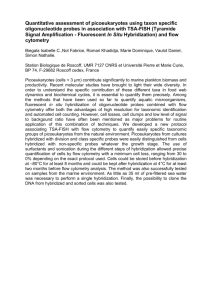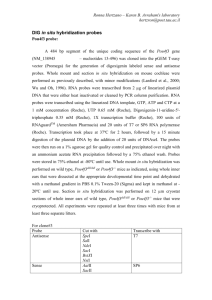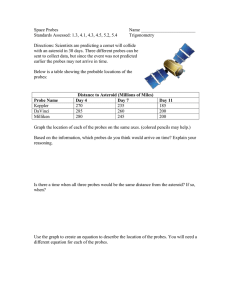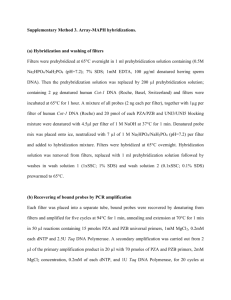Selection of Fluorophore and Quencher Pairs
advertisement
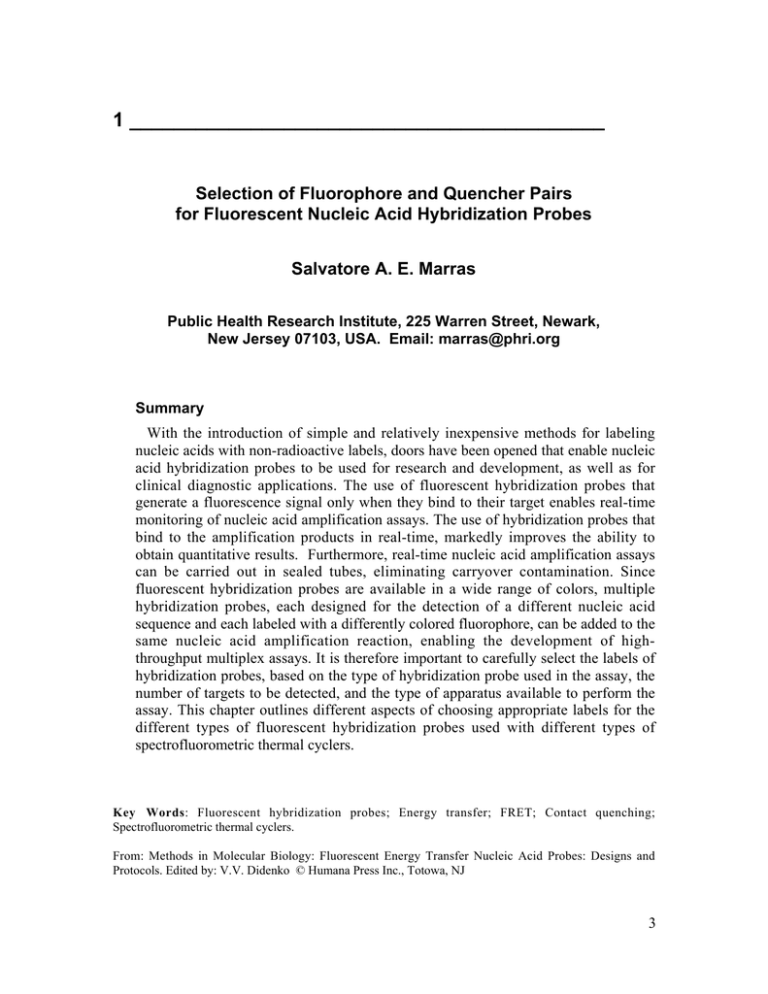
1 ___________________________________________ Selection of Fluorophore and Quencher Pairs for Fluorescent Nucleic Acid Hybridization Probes Salvatore A. E. Marras Public Health Research Institute, 225 Warren Street, Newark, New Jersey 07103, USA. Email: marras@phri.org Summary With the introduction of simple and relatively inexpensive methods for labeling nucleic acids with non-radioactive labels, doors have been opened that enable nucleic acid hybridization probes to be used for research and development, as well as for clinical diagnostic applications. The use of fluorescent hybridization probes that generate a fluorescence signal only when they bind to their target enables real-time monitoring of nucleic acid amplification assays. The use of hybridization probes that bind to the amplification products in real-time, markedly improves the ability to obtain quantitative results. Furthermore, real-time nucleic acid amplification assays can be carried out in sealed tubes, eliminating carryover contamination. Since fluorescent hybridization probes are available in a wide range of colors, multiple hybridization probes, each designed for the detection of a different nucleic acid sequence and each labeled with a differently colored fluorophore, can be added to the same nucleic acid amplification reaction, enabling the development of highthroughput multiplex assays. It is therefore important to carefully select the labels of hybridization probes, based on the type of hybridization probe used in the assay, the number of targets to be detected, and the type of apparatus available to perform the assay. This chapter outlines different aspects of choosing appropriate labels for the different types of fluorescent hybridization probes used with different types of spectrofluorometric thermal cyclers. Key Words: Fluorescent hybridization probes; Energy transfer; FRET; Contact quenching; Spectrofluorometric thermal cyclers. From: Methods in Molecular Biology: Fluorescent Energy Transfer Nucleic Acid Probes: Designs and Protocols. Edited by: V.V. Didenko © Humana Press Inc., Totowa, NJ 3 Interactive Fluorophore and Quencher Pairs Marras 1. Introduction 1.1. Fluorescence Energy Transfer During the last decade, many different types of fluorescent hybridization probes have been introduced. Although the mechanism of fluorescence generation is different among the different types of fluorescent hybridization probes, they all are labeled with at least one molecule, a fluorophore, that has the ability to absorb energy from light, transfer this energy internally, and emit this energy as light of a characteristic wavelength. In brief, following the absorption of energy (a photon) from light, a fluorophore will be raised from its ground state to a higher vibrational level of an excited singlet state. This process takes about one femtosecond (10-15 seconds). In the next phase, some energy is lost as heat, returning the fluorophore to the lowest vibrational level of an excited singlet state. This process takes about one picosecond (10-12 seconds). The lowest vibrational level of an excited singlet state is relatively stable and has a longer lifetime of approximately one to ten nanoseconds (1 to 10 x 10-9 seconds). From this excited singlet state, the fluorophore can return to its ground state, either by emission of light (a photon) or by a non-radiative energy transition. Light emitted from the excited singlet state is called fluorescence. Since some energy is lost during this process, the energy of the emitted fluorescence light is lower than the energy of the absorbed light, and therefore emission occurs at a longer wavelength than absorption. Different processes can decrease the intensity of fluorescence. Such decreases in fluorescence intensity are called “quenching”. Nowadays, most fluorescence detection techniques are based on quenching of fluorescence by energy transfer from one fluorophore to another fluorophore or to a non-fluorescent molecule. The next section describes two mechanisms of fluorescence quenching utilized by fluorescent hybridization probes. 1.2. Fluorescent Resonance Energy Transfer One mechanism of energy transfer between two molecules is fluorescence resonance energy transfer (FRET) or Förster type energy transfer (1). In this non-radiative process, a photon from an energetically excited fluorophore, the “donor”, raises the energy state of an electron in another molecule, the “acceptor”, to higher vibrational levels of the excited singlet state. As a result, the energy level of the donor fluorophore returns to the ground state, without emitting fluorescence. This mechanism is dependent on the dipole orientations of the molecules and is limited by the distance between the donor and the acceptor molecule. Typical effective distances between the donor and acceptor molecules are in the 10 to 100 Å range (2). This is roughly the distance between three to thirty nucleotides located in the double helix of a DNA molecule. Another requirement is that the fluorescence emission spectrum of the donor must overlap the absorption spectrum of the acceptor. The acceptor can be another fluorophore or a non-fluorescent molecule. If the acceptor is a fluorophore, the transferred energy can be emitted as fluorescence, 4 Interactive Fluorophore and Quencher Pairs Marras characteristic for that fluorophore. If the acceptor is not fluorescent, the absorbed energy is lost as heat. Examples of hybridization probes utilizing FRET for energy transfer between two molecules are adjacent probes and 5'-nuclease probes, which are described in the Subheading 1.3. 1.3. Contact quenching Quenching of a fluorophore can also occur as a result of the formation of a nonfluorescent complex between the fluorophore and another fluorophore or non-fluorescent molecule. This mechanism is known as “ground-state complex formation,” “static quenching,” or “contact quenching.” In contact quenching, the donor and acceptor molecules interact by proton-coupled electron transfer through the formation of hydrogen bonds. In aqueous solutions, electrostatic, steric and hydrophobic forces control the formation of hydrogen bonds. When this complex absorbs energy from light, the excited state immediately returns to the ground state without emission of a photon and the molecules do not emit fluorescent light. A characteristic of contact quenching is a change in the absorption spectra of the two molecules when they form a complex. In contrast, in the FRET mechanism, the absorption spectra of the molecules do not change. Among the hybridization probes that use this mechanism of energy transfer are molecular beacon probes and strand-displacement probes, which are described in Subheading 2. 2. Fluorescence Nucleic Acid Hybridization Probes Subheadings 2.1-2.4 provide short descriptions of the four main types of fluorescent hybridization probes that use FRET or contact quenching to generate a fluorescence signal to indicate the presence of a target nucleic acid: adjacent probes, 5'-nuclease probes, molecular beacon probes and strand-displacement probes. Other fluorescent hybridization probes are similar, or are based on one of the four main types of probes. Table 1 provides an overview of different types of fluorescent hybridization probes and their mechanism of energy transfer between fluorophore and quencher moieties. 2.1. Adjacent Probes “Adjacent probe” (or LightCycler™ hybridization probe) assays utilize two singlestranded hybridization probes that bind to neighboring sites on a target nucleic acid (see Fig. 1A) (3). One probe is labeled with a donor fluorophore at its 3' end, and the other probe is labeled with an acceptor fluorophore at its 5' end. The distance between the two probes, once they are hybridized, is chosen such that efficient fluorescence resonance energy transfer (FRET) can take place from the donor to the acceptor fluorophore. No energy transfer should occur when the two probes are free-floating, separated from each other in the solution. Hybridization of the probes to a target nucleic acid is measured by the decrease in donor fluorescence signal or the increase in acceptor fluorescence signal. 5 Interactive Fluorophore and Quencher Pairs Marras Table 1. Fluorescent nucleic acid hybridization probes and their mechanism of energy transfer Energy Transfer Fluorescent Hybridization Probes Adjacent probes (3) Amplifluor primers (6) Cyclicons (13) Contact Quenching FRET Yes No Possible A Yes Possible A Yes Duplex scorpion primers (9) No Yes HyBeacons (14) No Yes Minor Groove Binder (MGB) probes (15) Yes Possible B Possible A Yes Yes Possible B Possible A Yes No Yes Molecular beacon probes (5) 5'-nuclease probes (TaqMan probes) (4) Scorpion primers (7) Strand-displacement probes (Yin-Yang probes) (8) Wavelength-shifting molecular beacon probes (16) Possible A Yes A) Quenching of the fluorophore by FRET can occur if the fluorophore and quencher pair have spectral overlap and remain within sufficient distance of each other for efficient energy transfer to occur; B) Quenching of the fluorophore by contact quenching can occur if the fluorophore comes in close proximity to the quencher molecule or to a nucleotide, due to internal hybrid formation within the probe. 2.2. 5'-Nuclease Probes “5'-nuclease probe” (or TaqMan probe) assays utilize the inherent endonucleolytic activity of Taq DNA polymerase to generate a fluorescence signal (4). 5'-nuclease probes are single-stranded hybridization probes labeled with a donor-acceptor fluorophore pair that interact via FRET (see Figure 1B). The acceptor molecule can also be a nonfluorescent quencher molecule. Probes that are free in solution form “random coils,” in which the fluorophore is often close to the quencher molecule, enabling energy transfer from the donor fluorophore to the acceptor molecule, resulting in a low fluorescence signal from the donor fluorophore. The probe is designed to hybridize to its target DNA strand at the same time as the PCR primer. When Taq DNA polymerase extends the primer, it encounters the probe, and as a result of its 5'-nuclease activity, it cleaves the probe. Cleavage of the probe results in the separation of the donor fluorophore and acceptor molecule, and leads to an increase in the intensity of the fluorescence signal 6 Interactive Fluorophore and Quencher Pairs Marras from the donor fluorophore, because FRET can no longer take place. With each cycle of amplification, a new round of hybridization occurs and additional fluorophores are cleaved from their probes, resulting in higher fluorescence signals, indicating the accumulation of target DNA molecules. 2.3. Molecular Beacon Probes “Molecular beacon probe” assays utilize single-stranded hybridization probes that form a stem-and-loop structure (see Fig. 1C) (5). The loop portion of the oligonucleotide is a probe sequence (15 to 30 nucleotides long) that is complementary to a target sequence in a nucleic acid. The probe sequence is embedded between two “arm” sequences. The arm sequences (5 to 7 nucleotides long) are complementary to each other, but are not related to the probe sequence or to the target sequence. Under assay conditions, the arms bind to each other to form a double-helical stem hybrid that encloses the probe sequence, forming a hairpin structure. A reporter fluorophore is attached to one end of the oligonucleotide and a non-fluorescent quencher moiety is attached to the other end of the oligonucleotide. The stem hybrid brings the fluorophore and quencher in close proximity, allowing energy from the fluorophore to be transferred directly to the quencher through contact quenching. At assay temperatures, when the probe encounters a target DNA or RNA molecule, it forms a probe-target hybrid that is longer and more stable than the stem hybrid. The molecular beacon probe undergoes a conformational reorganization that forces the stem hybrid to dissociate and the fluorophore and the quencher are separated from each other, restoring fluorescence. Alternative fluorescent hybridization probes, based on the molecular beacon probe assays are “amplifluor primers” (6) and “scorpion primers” (7). 2.4. Strand-displacement probes “Strand-displacement probe” (or “Yin-Yang probe”) assays utilize two complementary oligonucleotide probes, one probe labeled with a fluorophore, and the other probe labeled with a non-fluorescent quencher moiety (see Fig. 1D) (8). When the two probes are hybridized to each other, the fluorophore and quencher are in close proximity and contact quenching occurs, resulting in low fluorescence emission. In the presence of a target nucleic acid, one of the probes forms a more stable probe-target hybrid, resulting the two probes being separate from each other. As a consequence of this displacement, the fluorophore and the quencher are no longer in close proximity and fluorescence increases. A similar method, based on strand-displacement, is utilized in “duplex scorpion primers” (9). 7 Interactive Fluorophore and Quencher Pairs Marras Figure 1. Schematic overview of energy transfer and fluorescence signal generation in fluorescent hybridization probes. 8 Interactive Fluorophore and Quencher Pairs Marras 3. Efficiency of energy transfer Since different types of fluorescent hybridization probes use different mechanisms for energy transfer, an important consideration in the design of oligonucleotide probes is the efficiency of energy transfer between the fluorophore and quencher used to label the probes. We have measured the quenching efficiency for 22 different fluorophores whose emission wavelength maximums range from 400 nm to 700 nm (10). Five different quenchers were tested with each of these fluorophores. Quenching efficiencies were measured for both fluorescence resonance energy transfer and for contact quenching. The following observations were made: 1. For all combinations of fluorophore and quenchers, the quenching efficiency by FRET decreased as the extent of spectral overlap between the absorption spectrum of the quencher and the emission spectrum of the fluorophore decreased. 2. The quenching efficiency of contact quenching did not decrease with the decrease in spectral overlap. 3. For every fluorophore-quencher pair, the efficiency of contact quenching was always greater than the efficiency of quenching by FRET. 4. In the FRET mode of quenching, quenchers that exhibited a broader absorption spectrum efficiently quenched a wider range of fluorophores than quenchers with a narrow absorption spectrum. 5. Fluorophore-quencher pairs that stabilize the hybrid have higher quenching efficiencies. 4. Selection of fluorophore-quencher pairs With the development of new nucleic acid synthesis chemistries and the introduction of new spectrofluorometric thermal cyclers, many manufactures have introduced new types of fluorescent hybridization probes and they promote them as being solely compatible with their products. Fortunately, most types of fluorescent hybridization probes are compatible with all available instruments. Many newly developed types of fluorescent probes are derived from, or utilize mechanisms that are similar to those used by adjacent probes, 5'-nuclease probes, molecular beacon probes or strand displacement probes. The end user should therefore consider what spectrofluorometric thermal cycler platform is available, whether the assays that they perform require multiplexing or high sample throughput, and whether the type of fluorescent hybridization probe they choose provides the specificity and sensitivity required to meet the goals of their research or clinical diagnostic applications. Table 2 provides an overview of the spectrofluorometric thermal cyclers currently available. The table specifies the type of excitation source that is utilized in each instrument, what fluorophores are compatible with the optics of each instruments, how many different fluorophores can be analyzed in a single assay (multiplex capability), how many samples can be analyzed simultaneously, and what type of hybridization probes can be used with each instrument. The fluorophores listed in the table can be replaced with alternative fluorophores (listed in Table 3) that exhibit similar 9 Interactive Fluorophore and Quencher Pairs Marras excitation and emission spectra and are available from different vendors. Table 4 provides a list of available quencher moieties. The following guidelines can be followed in choosing the appropriate fluorophorequencher combinations for the different types of fluorescent hybridization probes and spectrofluorometric thermal cyclers: 1. Based on the spectrofluorometric thermal cycler platform that is available, choose appropriate fluorophore labels that can be excited and detected by the optics of the instrument. Instruments equipped with an Argon blue-light laser are optimal for excitation of fluorophores with an excitation wavelength between 500 and 540 nm, however fluorophores with a longer excitation maximum are less well, or not at all, excited by this light source. Instruments with a white light source, such as a Tungsten-halogen lamp, use filters for excitation and emission, and are able to excite and detect fluorophores with an excitation and emission wavelength between 400 and 700 nm, with the same efficiency. This is also the case for instruments that use light emitting diodes as excitation source and emission filters for the detection of a wide range of fluorophores. 2. If the assay is designed to detect one target DNA sequence and only one fluorescent hybridization probe will be used, then FAM, TET, or HEX (or one of their alternatives listed in Table 3) will be a good fluorophore to label the probe. These fluorophores can be excited and detected on all available spectrofluorometric thermal cyclers. In addition, because of the availability of phosphoramidites derivatives of these fluorophores and the availability of quencher-linked controlpore glass columns, fluorescent hybridization probes with these labels can be entirely synthesized in an automated DNA synthesis process, with the advantage of relatively less expensive and less labor intensive probe manufacture. 3. If the assay is designed for the detection of two or more target DNA sequences (multiplex amplification assays), and therefore two or more fluorescent hybridization probes will be used, choose fluorophores with absorption and emission wavelengths that are well separated from each other (minimal spectral overlap). Most instruments have a choice of excitation and emission filters that minimize the spectral overlap between fluorophores. To the extent that spectral overlap occurs, the instruments are supported by software programs with build-in algorithms to determine the emission contribution from each of the fluorophores present in the amplification reaction. In addition, most instruments have the option to manual calibrate the optics for the fluorophores utilized in the assay to further optimize the determination of emission contribution of each fluorophore. 10 Interactive Fluorophore and Quencher Pairs Marras 11 Interactive Fluorophore and Quencher Pairs Marras Table 3. Fluorophore labels for fluorescent hybridization probes Fluorophore Alternative Fluorophore FAM Excitation Emission (nm) (nm) 495 515 TET CAL Fluor Gold 540 A 525 540 HEX JOE, VIC B, CAL Fluor Orange 560 A 535 555 Cy3 C NED B, Quasar 570 A, Oyster 556 D 550 570 TMR CAL Fluor Red 590 A 555 575 ROX LC red 610 E, CAL Fluor Red 610 A 575 605 Texas red LC red 610 E, CAL Fluor Red 610 A 585 605 LC red 640 E CAL Fluor Red 635 A 625 640 Cy5 C LC red 670 E, Quasar 670 A, Oyster 645 D 650 670 LC red 705 E Cy5.5 C 680 710 A) CAL and Quasar fluorophores are available from Biosearch Technologies; B) VIC and NED are available from Applied Biosystems; C) Cy dyes are available from Amersham Biosciences; D) Oyster fluorophores are available from Integrated DNA Technologies; and E) LC (Light Cycler) fluorophores are available from Roche Applied Science. 4. For the design of fluorescent hybridization probes that utilize fluorescence resonance energy transfer (FRET), fluorophore-quencher pairs that have sufficient spectral overlap should be chosen. Fluorophores with an emission maximum between 500 and 550 nm, such as FAM, TET and HEX, are best quenched by quenchers with absorption maxima between 450 and 550 nm, such as dabcyl and BHQ-1 (s e e Table 4 for alternative quencher labels). Fluorophores with an emission maximum above 550 nm, such as rhodamines (including TMR, ROX and Texas red) and Cy dyes (including Cy3 and Cy5) are best quenched by quenchers with absorption maxima above 550 nm (including BHQ-2). 5. For the design of fluorescent hybridization probes that utilize contact quenching, any non-fluorescent quencher can serve as a good acceptor of energy from the fluorophore. However, it is our experience that Cy3 and Cy5 are best quenched by the BHQ-1 and BHQ-2 quenchers. 12 Interactive Fluorophore and Quencher Pairs Marras Table 4. Quencher labels for fluorescent hybridization probes Quencher Absorption Maximum (nm) DDQ-I A 430 Dabcyl 475 Eclipse B 530 Iowa Black FQ C 532 BHQ-1D 534 QSY-7 E 571 BHQ-2 D 580 DDQ-II A 630 Iowa Black RQ C 645 QSY-21 E 660 BHQ-3 D 670 A) DDQ or Deep Dark Quenchers are available from Eurogentec; Eclipse quenchers are available from Epoch Biosciences; C) Iowa quenchers are available from Integrated DNA Technologies; D) BHQ or Black Hole quenchers are available from Biosearch Technologies; and E) QSY quenchers are available from Molecular Probes. B) 6. Fluorophores exhibit specific quantum yields. Fluorescence quantum yield is a measure of the efficiency with which a fluorophore is able to convert absorbed light to emitted light. Higher quantum yields result in higher fluorescence intensities. Quantum yield is sensitive to changes in pH and temperature. Under most nucleic acid amplification reaction conditions, pH and temperature do not change much and therefore the quantum yield will not change significantly. However, in optimizing nucleic acid amplification reactions, quantum yields might change as assay temperatures vary. As a result, lower fluorescence signals at higher temperatures can be falsely interpreted to mean that the fluorescent hybridization probe did not hybridize to its nucleic acid target, when what actually occurred was that the decrease in fluorescence was primarily due to a lower quantum yield of the fluorophore label. Figure 2 shows the relation between quantum yield and temperature for some of the most common fluorophores. TET, HEX, ROX and 13 Interactive Fluorophore and Quencher Pairs Marras Texas red do not show a significant change in their quantum yield with increasing temperature, whereas FAM and TMR show a constant moderate decrease in quantum yield with increasing temperature. On the other hand, the Cy dyes, Cy3 and Cy5, show a decrease of almost 70% of their quantum yield at 65 °C compared to their quantum yield at room temperature. As a consequence, in order to obtain significant fluorescence signals with hybridization probes labeled with Cy3 and Cy5 fluorophores in assays that are carried out at higher reaction temperatures, higher concentrations of the hybridization probes should be added to the reactions. On the other hand, platforms that are designed for monitoring the fluorescence of Cy dyes, such as Cepheid’s SmartCycler® (see Table 2), perform the calibration of the optics for these fluorophores at 60 °C to obtain optimal sensitivity. Figure 2. Effect of temperature on the quantum yield of fluorophores. The fluorophores TET, HEX, ROX and Texas red do not show a significant change in their quantum yield with increasing temperature. The fluorophores FAM and TMR show a moderate constant decrease in their quantum yield with increasing temperature, whereas the fluorophores Cy3 and Cy5 show a sharp decrease in their quantum yield with increasing temperature. 7. Nucleotides can quench the fluorescence of fluorophores, with guanosine being the most efficient quencher, followed by adenosine, cytidine and thymidine (11). In general, fluorophores with an excitation wavelength between 500 and 550 nm are quenched more efficiently by nucleotides than fluorophores with longer excitation wavelengths. In designing fluorescent hybridization probes, try to avoid placing a fluorophore label directly next to a guanosine, to ensure higher fluorescence signals from the fluorophore. 14 Interactive Fluorophore and Quencher Pairs 8. Marras The stabilizing effect of some fluorophore-quencher pairs that interact by contact quenching has important consequences for the design of hybridization probes (10,12). In our experience, hybridization probes labeled with a fluorophore quenched by either BHQ-1 or BHQ-2 show an increase in hybrid melting temperature of about 4 °C, compared to hybridization probes with the same probe sequence, but labeled with fluorophores quenched by dabcyl. We observed the strongest affinity between the Cy dyes, Cy3 and Cy5, and the Black Hole quenchers, BHQ-1 and BHQ-2. The ongoing development of fluorescent nucleic acid hybridization probes will result in the introduction of more fluorophore-quencher pairs, with improved biophysical and biochemical properties and wider range of color selection. Together with the introduction of new spectrofluorometric thermal cyclers that allow more fluorophores to be excited and detected simultaneously, this will enable even higher throughput multiplex assays for the sensitive and specific detection of nucleic acids. Acknowledgements The studies on the measurements of quenching efficiencies in fluorescent hybridization probes described in this chapter are the result of a collaboration with Dr. Fred Russell Kramer and Dr. Sanjay Tyagi and were supported by National Institutes of Health Grants EB-000277 and GM-070357. References 1. 2. 3. 4. 5. Förster, T. (1948) Intermolecular energy migration and fluorescence. Ann. Phys. (Leipzig) 2, 55-75. Translated by R.S. Knox. Haugland, R.P., Yguerabide, J. and Stryer, L. (1969) Dependence of the kinetics of singlet-singlet energy transfer on spectral overlap. Proc. Natl Acad. Sci. USA 63, 23-30. Wittwer, C.T., Herrmann, M.G., Moss, A.A. and Rasmussen, R.P. (1997) Continuous fluorescence monitoring of rapid cycle DNA amplification. Biotechniques 22, 130-131. Livak, K.J., Flood, S.J., Marmaro, J., Giusti, W. and Deetz, K. (1995) Oligonucleotides with fluorescent dyes at opposite ends provide a quenched probe system useful for detecting PCR product and nucleic acid hybridization. PCR Methods Appl. 4, 357-362. Tyagi, S. and Kramer, F.R. (1996) Molecular beacons: probes that fluoresce upon hybridization. Nat. Biotechnol. 14, 303-308. 15 Interactive Fluorophore and Quencher Pairs 6. 7. 8. 9. 10. 11. 12. 13. 14. 15. 16. Marras Nazarenko, I.A., Bhatnagar, S.K. and Hohman, R.J. (1997) A closed tube format for amplification and detection of DNA based on energy transfer. Nucleic Acids Res. 25, 2516-2521. Whitcombe, D., Theaker, J., Guy, S.P., Brown, T. and Little, S. (1999) Detection of PCR products using self-probing amplicons and fluorescence. Nat. Biotechnol. 17, 804-807. Li, Q., Luan, G., Guo, Q. and Liang, J. (2002) A new class of homogeneous nucleic acid probes based on specific displacement hybridization. Nucleic Acids Res. 30, e5. Solinas, A., Brown, L.J., McKeen, C., Mellor, J.M., Nicol, J., Thelwell, N., et al. (2001) Duplex Scorpion primers in SNP analysis and FRET applications. Nucleic Acids Res. 29, e96. Marras, S.A., Kramer, F.R. and Tyagi, S. (2002) Efficiencies of fluorescence resonance energy transfer and contact-mediated quenching in oligonucleotide probes. Nucleic Acids Res. 30, e122. Seidel, C.A.M., Schulz, A. and Sauer, M.M.H. (1996) Nucleobase-specific quenching of fluorescent dyes. 1. Nucleobase one-electron redox potentials and their correlation with static and dynamic quenching efficiencies. J. Phys. Chem. 100, 5541-5553. Johansson, M.K., Fidder, H., Dick, D. and Cook, R.M. (2002) Intramolecular dimers: a new strategy to fluorescence quenching in dual-labeled oligonucleotide probes. J. Am. Chem. Soc. 124, 6950-6956. Kandimalla, E.R. and Agrawal, S. (2000) “Cyclicons” as hybridization-based fluorescent primer-probes: synthesis, properties and application in real-time PCR. Bioorg. Med. Chem. 8, 1911-1916. French, D.J., Archard, C.L., Brown, T. and McDowell, D.G. (2001) HyBeacon™ probes: a new tool for DNA sequence detection and allele discrimination. Mol. Cell Probes 15, 363-374. Kutyavin, I.V., Afonina, I.A., Mills, A., Gorn, V.V., Lukhtanov, E.A., Belousov, E.S., et al. (2000) 3'-minor groove binder-DNA probes increase sequence specificity at PCR extension temperatures. Nucleic Acids Res. 28, 655-661. Tyagi, S., Marras, S.A. and Kramer, F.R. (2000) Wavelength-shifting molecular beacons. Nat. Biotechnol. 18, 1191-1196. 16

